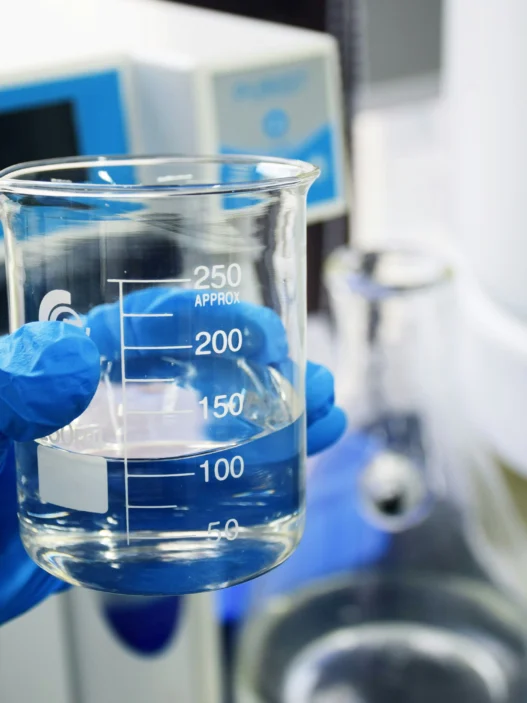N-Phenyl-1-naphthylamine is a chemical compound commonly used as an antioxidant and stabilizer in the manufacturing of rubber products, lubricants, and plastics. Its primary function is to prevent degradation and prolong the useful lifespan of these materials by inhibiting the effects of oxidation. While the average consumer may not directly encounter this compound in everyday life, its presence in essential industrial applications ensures the reliability and durability of numerous goods and products that we rely on daily.
Table of Contents:
- 💡 Commercial Applications
- ⚗️ Chemical & Physical Properties
- 🏭 Production & Procurement
- ⚠️ Safety Considerations
- 🔬 Potential Research Directions
- 🧪 Related Compounds
💡 Commercial Applications
N-Phenyl-1-naphthylamine, also known as NPN, has several commercial and industrial applications. It is commonly used as an antioxidant in rubber production, where it helps prevent the material from deteriorating due to exposure to oxygen and heat. NPN is also utilized as a stabilizer in the production of various polymers and plastics, where it helps prevent degradation caused by UV radiation and other environmental factors.
In the pharmaceutical industry, N-Phenyl-1-naphthylamine has potential drug and medication applications. Some research suggests that NPN may have anti-inflammatory properties, making it a potential candidate for the development of new medications aimed at treating inflammatory conditions. Additionally, NPN has shown promise in preclinical studies as a potential anti-cancer agent, although further research is needed to fully understand its therapeutic potential in this area.
⚗️ Chemical & Physical Properties
N-Phenyl-1-naphthylamine, also known as PAN, appears as a white to pale yellow crystalline solid with a faint odor. It is sparingly soluble in water but soluble in organic solvents.
With a molar mass of 219.29 g/mol and a density of 1.16 g/cm³, N-Phenyl-1-naphthylamine is relatively light compared to common food items like sugar (molar mass of 342.3 g/mol) and denser than water (density of 1 g/cm³).
N-Phenyl-1-naphthylamine has a melting point of around 60-62°C and a boiling point of approximately 340°C. These properties are higher than those of most common food items, such as butter and chocolate, which melt at lower temperatures.
When it comes to solubility in water, N-Phenyl-1-naphthylamine is sparingly soluble. It also exhibits a relatively high viscosity compared to common food items like milk and water.
🏭 Production & Procurement
N-Phenyl-1-naphthylamine, a chemical compound primarily used as an antioxidant in rubber manufacturing, is typically produced through a series of chemical reactions. The synthesis of N-Phenyl-1-naphthylamine involves the condensation of 1-naphthylamine with an excess of benzaldehyde in the presence of an acid catalyst. This process results in the formation of N-Phenyl-1-naphthylamine as the final product.
Once produced, N-Phenyl-1-naphthylamine can be procured from chemical suppliers or manufacturers specializing in the production of rubber additives. This compound is commonly available in various grades and quantities to suit the specific needs of industries requiring antioxidants for rubber products. In terms of transportation, N-Phenyl-1-naphthylamine is typically packaged in drums or bags and shipped following regulatory guidelines for the transportation of hazardous chemicals.
⚠️ Safety Considerations
Safety considerations for N-Phenyl-1-naphthylamine include the potential for skin and eye irritation, as well as respiratory tract irritation if inhaled. It is important to wear appropriate personal protective equipment such as gloves, safety goggles, and a lab coat when handling this chemical. Additionally, N-Phenyl-1-naphthylamine should be stored in a well-ventilated area away from incompatible substances to prevent accidental reactions.
Hazard statements for N-Phenyl-1-naphthylamine include “May cause respiratory irritation” and “Causes skin and eye irritation.” These statements indicate that exposure to this chemical can result in harm to the respiratory system as well as the skin and eyes. It is important to take proper precautions to avoid direct contact with N-Phenyl-1-naphthylamine to prevent these potential hazards.
Precautionary statements for N-Phenyl-1-naphthylamine include “Wear protective gloves/eye protection/face protection” and “IF IN EYES: Rinse cautiously with water for several minutes. Remove contact lenses, if present and easy to do.” These statements emphasize the importance of wearing appropriate personal protective equipment and taking immediate action in case of exposure to this chemical. It is essential to follow these precautions to minimize the risk of harm when working with N-Phenyl-1-naphthylamine.
🔬 Potential Research Directions
Research on N-Phenyl-1-naphthylamine could explore its potential applications in various industries such as rubber and plastics manufacturing. Investigating its properties as an antioxidant and UV stabilizer in polymers could open new avenues for material science research.
Additionally, studies could focus on the toxicity and environmental impact of N-Phenyl-1-naphthylamine, especially in terms of its persistence in the environment and potential bioaccumulation in organisms. Understanding the risks associated with the use of this compound can help in developing regulations and guidelines for its safe handling and disposal.
Furthermore, research could delve into the synthesis and modification of N-Phenyl-1-naphthylamine to improve its effectiveness as an antioxidant or UV stabilizer. Exploring different chemical reactions and molecular structures could lead to the development of more efficient and environmentally friendly alternatives for various industrial applications.
🧪 Related Compounds
One of the similar compounds to N-Phenyl-1-naphthylamine based upon molecular structure is N-Phenyl-2-naphthylamine. This compound also contains a naphthyl group attached to a phenyl group through an amino linkage. The only difference between N-Phenyl-1-naphthylamine and N-Phenyl-2-naphthylamine is the position of the naphthyl group on the naphthalene ring.
Another similar compound is N-Phenyl-2-naphthalenamine, which shares a similar structure to N-Phenyl-1-naphthylamine but differs in the number of carbon atoms present in the naphthalene ring. Both compounds contain a phenyl group attached to a naphthalene ring through an amino linkage.
N-Phenyl-2-naphthylmethanamine is also a compound similar to N-Phenyl-1-naphthylamine in terms of molecular structure. This compound contains a phenyl group attached to a naphthylmethyl group through an amino linkage. The main difference between N-Phenyl-1-naphthylamine and N-Phenyl-2-naphthylmethanamine is the presence of a methyl group on the naphthyl group in the latter compound.





